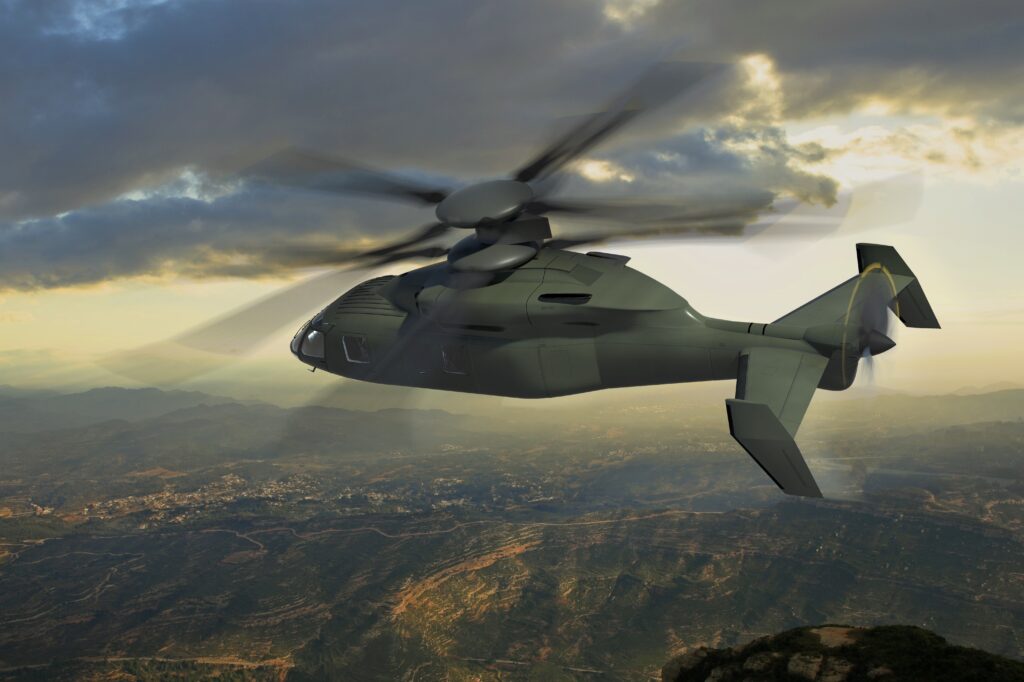
The Sikorsky-Boeing SB-1 Defiant concept for the Joint Multi-Role demonstrator, a predecessor to the Future Vertical Lift aircraft.
AMARILLO, TEX.: The Future Vertical Lift program aims to create revolutionary replacements for today’s military helicopters. But how? And why? The answers lie in the speed limits built into the physics of how a helicopter flies.
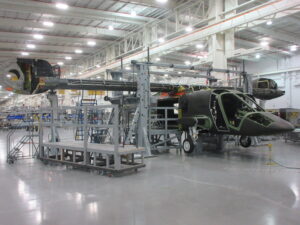
V-280 Valor under construction
Rival contractors Bell and Sikorsky (part of Lockheed Martin) both say they have transcended those limits to build dramatically faster rotorcraft, but they have taken very different paths. Both companies agree that the Bell V-280 Valor, which has wings, is more fuel-efficient in long-range flight than the Sikorsky-Boeing SB>1 Defiant, which just has rotors. However, they each claim their aircraft is more agile – a crucial consideration when landing troops in tight spaces or ducking behind hills and trees to hide from radar.
[Click here for Bell’s argument for accelerating FVL — by cancelling other programs]
Will the military actually buy either design? The Marine Corps is more than receptive to radically new rotorcraft. It has already committed heavily to the V-22 Osprey tiltrotor jointly built by Bell and Boeing. The Air Force and Navy are also buying small numbers of V-22s. But the Army has bought none, and it’s by far the largest US helicopter buyer, with over 2,000 UH-60 Black Hawks alone that need to be replaced, some day. It’s the Army that Bell and Sikorsky must convince.

CH-47F Chinook
So it should be no surprise that, ahead of next week’s mammoth Association of the US Army conference in Washington, Bell flew reporters out to its factory here to talk up the V-280 Valor and to denigrate the Sikorsky-Boeing SB>1 Defiant. (Bell’s partner on the V-22, Boeing, switched sides on FVL). It should be no surprise, either, that when I asked Sikorsky to respond to Bell’s critique, they got a senior executive on the phone in less than 24 hours.
Despite all the differences, the fundamental selling points for both designs are speed and range. The fastest Army helicopter in widespread service, the CH-47F Chinook, maxes out at about 170 knots, which is 195 miles per hour, and has an effective reach (mission radius) of 200 nautical miles, or 230 statute miles. If you want to go faster and further, you need a fundamentally different design. The Bell-Boeing V-22s now in service, for example, cruise comfortably at 270 knots, about 310 miles per hour, with a mission radius of 428 nautical miles, about 490 miles (and that, of course, is without being refueled). The FVL competitors haven’t flown yet, but the Bell V-280 is designed to go 280 knots (320 mph), while the Sikorsky-Boeing SB>1 is derived from the Collier Trophy-winning X2 demonstrator, which reached 250 knots (287 mph).
Why so different?
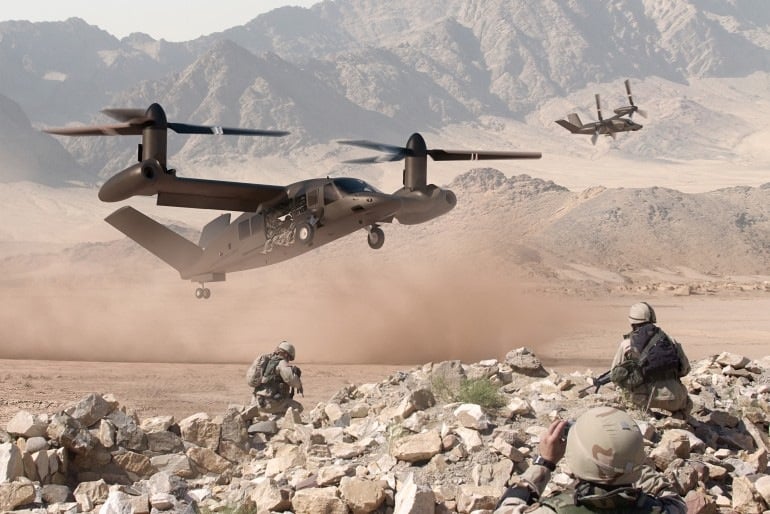
Bell V-280 Valor Joint Multi-Role Demonstrator (CGI graphic)
Helicopter Physics 101
Helicopters don’t really fly, they just beat the air into submission. It’s an old joke with a kernel of aerodynamic truth.
A fixed-wing aircraft has engines to generate forward thrust – jets or propellers – and as it moves forward, air flows over the wings, which generates lift. Since you can only generate lift by moving the whole aircraft forward, you need a long runway to take off and must keep moving forward while in flight. (Move too slowly and you stall, potentially falling out of the sky).
A helicopter, however, generates airflow over the wings, and thus, lift by spinning its wings – that’s what the rotor blades are, “rotary wings.” It generates thrust by angling the rotors – in any direction. That lets them take off and land vertically, fly sideways or backwards, and hover, but it’s not as fast or as fuel efficient in horizontal flight as an airplane.
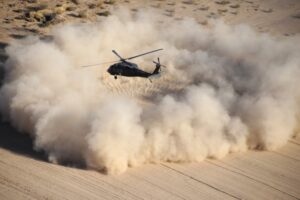
Army UH-60 Black Hawk
At higher speeds, moreover, helicopters run into a problem called retreating blade stall. Remember, rotors rotate. At any given time, half a helicopter’s rotors – the “advancing blades” – are moving forward, from the tail towards the nose, but the other half – the “retreating blades” – are moving backward, from the nose to the tail. The advancing blades are effectively going faster, relative to the air, because they add the helicopter’s forward movement to their own, so they generate more lift. The retreating blades are going slower relative to the air, because they subtract the helicopter’s speed from their own, so they generate less lift.
At low speeds, the difference between the advancing and retreating blades is negligible. At higher speeds, however, the advancing blades start going supersonic – producing dangerous vibrations – while the retreating blades stall out for lack of lift. At this point, the pilot has two choices: slow down or crash.
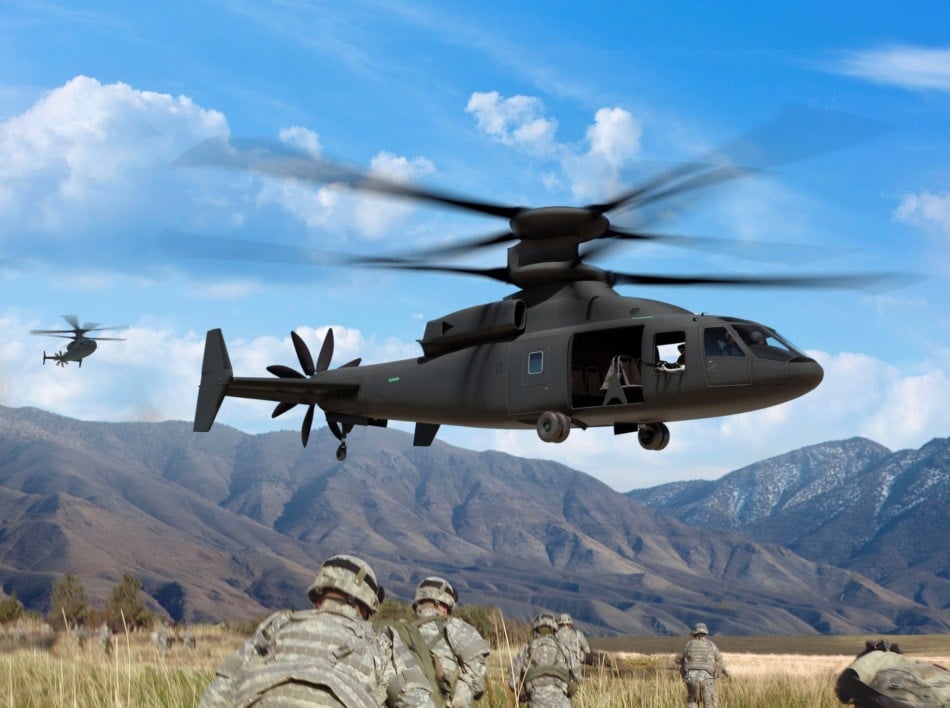
Sikorsky-Boeing SB>1 Defiant
The Two Designs
There are two main ways to overcome this inherent speed limit of helicopters: tilt-rotors, like Bell’s V-280, or compound helicopters, like the Boeing-Sikorsky SB>1. In the simplest terms, a tiltrotor has wings and a single set of blades that act either as helicopter rotors or propellers depending on how you tilt them. A compound helicopter has no wings and two separate sets of blades, a rotor that stays a rotor and a propeller that stays a propeller.
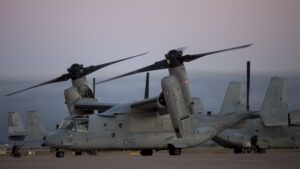
V-22
Starting with the experimental XV-15 in the 1970s, and entering military service with the V-22 in 2007, Bell has led the industry in building tilt-rotors, winged aircraft with rotors that, well, tilt. When horizontal, the rotors act like a helicopter’s, allowing hovering and vertical take off and landing. When vertical, they act like giant propellers, allowing fast and fuel-efficient flight with no risk of retreating blade stall (because of the angle at which they meet the air). The downside of a tilt-rotor is the mechanical complexity and weight of the mechanisms needed to do the tilting – as well as the need to switch modes in flight.
Sikorsky’s compound-helicopter experiments also started in the 1970s with the experimental XH-59, then were revived in the X2 demonstrator – now in the Smithsonian. They were refined in the S-97 Raider and now the SB>1. They’re called “compound” because they have two sets of blades. First, like some conventional helicopters, especially Russian designs, a compound helicopter has two coaxial rotors on top that rotate in opposite directions (counter-rotation). The extra lift from each rotor’s advancing blade balances out the diminished lift from the opposite side’s retreating blade, which gets rid of retreating blade stall. It doesn’t get rid of excessive vibration at high speed, but exceptionally rigid rotor materials and advanced vibration controls do, Sikorsky says

Sikorsky X-2 demonstrator
Second, to provide the raw forward thrust for fast flight, the back of the aircraft mounts a pusher propeller. When the compound helicopter is hovering, the rotors on top get most of the engine power and do most of the work, much like a traditional helicopter. When it’s moving forward at high speed, however, the engine puts 90 percent of its energy into the rear propeller to generate forward thrust, much like a conventional propeller aircraft.
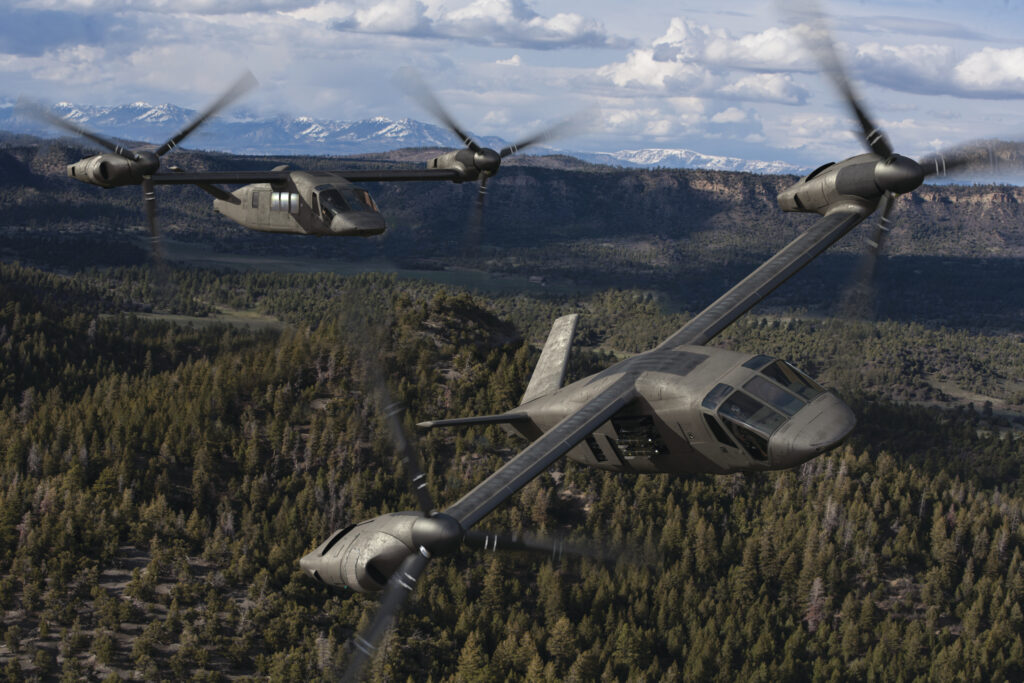
Bell V-280s
The Comparison
So which system’s better? That depends on who you believe and what the mission is.
A compound helicopter is “a little less efficient than a tiltrotor flying long distances,” Sikorsky’s VP for innovation, Chris Van Buiten, admitted to me. “But the mission is not simply to fly long distances. (With a tiltrotor,) while it is efficient in its cruising mission, it struggles when it gets to the objective.”
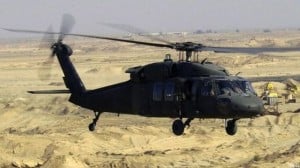
UH-60 Black Hawk

AH-64E Apache
To replace the Army’s current Black Hawk transports, an aircraft needs to be able to land quickly in tight spaces under fire, drop troops, and then take off again – ideally flying backwards so it doesn’t have to wait to turn around. To replace the Apache gunships, an aircraft needs to fly low and slow over the battlefield, ducking behind cover when enemy anti-aircraft units appear, then popping up again to fire guns and missiles. You don’t want to wait for your rotors to tilt from vertical to horizontal flight mode like a V-22 or V-280, Van Buiten argued.
Bell, naturally, disagrees. They’ve learned a lot since they built the V-22, said V-280 program manager Chris Gehler, and they’ve “radically upgraded the low-speed handling qualities,” he told reporters in Amarillo. That required changing how the rotors flap, improving materials, and, above all, increasing the size of the rotors relative to the aircraft. The V-280 has the same size rotors as the V-22 but weighs half as much, Gehler said, giving it “50 percent more control power than a V-22” at low speeds, superior to the present-day Black Hawk and Apache.
At high speeds, Gehler claimed, tiltrotors are “far and away” more maneuverable than compound helicopters: “Right now, compound coax is having challenges turning at high speed.”
That’s true of less sophisticated compound helicopter designs, said Van Buiten, but not of theirs, in large part because of the two counter-rotating rotors. In effect, he said, “the rotor behaves like a wing in high-speed flight and we have tremendous agility.”
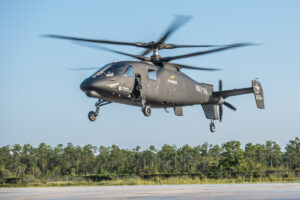
Sikorsky S-97 on its first flight
What does an independent expert think? “In general, tiltrotors don’t offer the kind of agility and maneuverability that a compound design does,” said Richard Aboulafia, aviation analyst at the Teal Group.
That might require different designs for different missions and different services, Aboulafia told me, with the military ending up with a mix of tiltrotors, compound helicopters, and traditional helicopters. While the Army’s currently leading the most near-term parts of Future Vertical Lift, “the overwhelming bulk of Army rotorcraft requirements involve transport, where FVL’s virtues don’t matter much. With faster speeds, you get less lift capacity unless you want to pay more. However, it’s quite possible that they go with the Boeing-Sikorsky Raider design (the SB>1’s smaller brother) for scout and attack missions, where survivability and lethality are worth paying for.”
“The V-280, by contrast looks purely like a Marine design,” Aboulafia said. Despite talk of far-ranging maneuvers and Multi-Domain Battles, he doubts the Army will be willing to pay a high premium for speed and range, which the Marines have already proven willing to do on the V-22. His prediction: The Marines double down on tiltrotors, the Army will keep upgrading conventional helicopters for the bulk of its fleet, and a smaller number of compound helicopters will be built as gunships and scouts.
Updated 4:55 pm to clarify Richard Aboulafia’s remarks on Army preferences.
China’s new H-20 stealth bomber ‘not really’ a concern for Pentagon, says intel official
“The thing with the H-20 is when you actually look at the system design, it’s probably nowhere near as good as US LO [low observable] platforms, particularly more advanced ones that we have coming down,” said a DoD intelligence official.


























